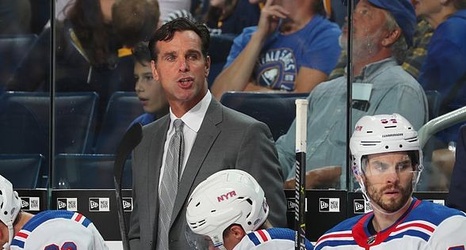
The NY Rangers swept the Carolina Hurricanes are gearing up for their matchup in the play-in round. The Rangers swept the season series, going 3-0 behind the stellar play of Henrik Lundqvist. But as we know, that doesn’t guarantee success in the play-in round. Both teams have had months to prepare for their five-game series. Luck will certainly play a factor, as it always does, but luck favors the prepared.
When it comes to how both teams play, this series may be a game of adjustments by the players and the coaching staff. The way both teams play is pretty obvious, and both teams have easily exploitable holes in those styles of play.
Forecheck
Adam Herman at Blueshirt Banter broke down how Carolina is primarily a dump-and-chase team. I’m not going to re-hash that entire post, and it’s great detail with stats and video of how Carolina is successful offensively. You should go read it. I’ll wait.
Long story short, Carolina uses a 2-1-2 forecheck, an aggressive style which complements their team structure well. They rely heavily on their strong defensive unit to cover any mistakes in the offensive zone that may lead to chances against.
As Adam mentioned in his post, the Rangers have three defensemen (Tony DeAngelo, Jacob Trouba, Adam Fox) and one goalie (Igor Shesterkin) who excel at puck movement. Their skills quick decision making buys valuable seconds to make reads and break the forecheck for a rush of their own.
This enables the Rangers to be a quick-strike team against the Canes, something that is evident in the three matchups from this season. The Canes dominated the Rangers in two of the three games, yet it was a quick strike offense and elite goaltending that got them the wins. That quick strike offense is due to those puck movers that get the puck out of dangerous situations, then start the rush the other way.
With Carolina sending F1 and F2 in deep on the forecheck, every millisecond counts. The Rangers just happen to be good at this aspect of their game. Where Carolina lacks in skilled depth, the Rangers make up for. The Canes, with mediocre goaltending, are susceptible to this kind of counter attack.
Zone Entries
The Rangers, while good at escaping dangerous situations, are awful at defending zone entries. They are one of the worst teams in the league at allowing zone entries against, and it seems to be by design.
— Corey Sznajder (@ShutdownLine) July 9, 2020
Interestingly enough, the three best puck movers on the blue line are also the three best at defending zone entries. But that doesn’t hide the fact that the Rangers allow roughly 60% of zone entries to be carry-ins. Also not a coincidence is teams targeting the left side more than the right.
The goal for the Rangers is to force teams to the outside and eliminate the slot area. They weren’t good at that to start the year, but got better as the season progressed.
This is where the game of adjustments comes into play. If Rod Brind’Amour is going to exploit a weakness on the Rangers, this is the weakness to exploit.
https://twitter.com/BlueSeatBlogs/status/1180626458567467008
You’ll have to excuse the crude footage of my TV – I don’t have NHL.tv to record streams. What we see above is the Rangers backing off starting at the red line all the way to the top of the circles. This leads to puck watching possibilities along the high slot and more controlled offensive time for the opposition.
The skilled players on Carolina will be able to exploit defenders backing off and giving them room. Carolina has a bunch of them as well. Given the above information, Carolina would be smart in attacking the left defense, which is notably weak.
That matchup (presumably) pits Teuvo Teravainen against Brendan Smith, Matin Necas against Ryan Lindgren, and Justin Williams against Marc Staal, if we look at the top three RWs versus the presumed pairs. Maybe Lindgren wins a few against Necas, but the other two matchups heavily favor the Hurricanes.
The Adjustments
For this Rangers/Hurricanes matchup, adjustments are key. If Carolina decides to carry-in more than dump-and-chase, then F1 on the Rangers plays a critical role. This is where the puck watching above is critical. With D1 and D2 backing off, F1 is critical in making the read and taking away the slot pass. This is something Shayna Goldman at The Athletic broke down in December.
F1 making the right read eliminates the high danger slot pass option. That leaves two options – drive the outside or find the trailer. Driving the outside is safer, but limits quality chances. That said, given the defensive zone issues the Rangers do have, it might drive chaos, something else Herman mentioned in his post. The trailer represents the middle danger chance, but also leaves room for turnovers.
Counter attack is the name of the game for the Rangers. Forcing the Hurricanes into bad choices between the blue line and the top of the circle allows them to take advantage of their biggest strength – transition defensemen. Force the turnover, let the defensemen counter and get the puck to F2 and F3 to start the counter attack up the ice.
In this matchup between the Hurricanes and the Rangers, both coaches are going to be playing a game of chess. There are clear counters to each strategy, and it’s up to the coaches to instruct their players in real time to adjust and counter. The series may come down to luck, but the prepared coach manufactures his own luck.
Share:
More About:Hockey Tactics
